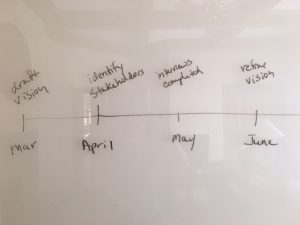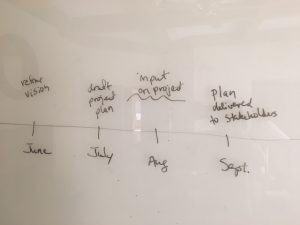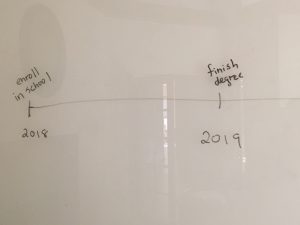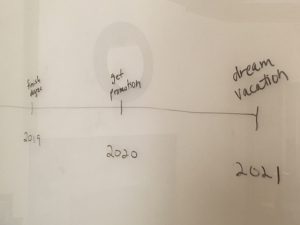We are made from the stuff of exploded stars in an ever-expanding universe.
Recent research on leadership shows that if it can be learned, it can be taught. As a corollary, I believe that like leadership, visioning can be taught as well. My own research shows that theories about visioning often lead to conversations about strategic planning. While the exercises outlined here can be used for strategic planning, I’d like to focus on how they work as guided activities for individuals and teams to help build their visioning muscles.
For the newbie
When I’m working with someone who is new to the idea of visioning, I start with baby steps. An easy exercise is creating a horizontal timeline for something simple like a time-bound project. It works best when I let the person hold the marker, and I ask questions about the project as they mark up the white board. We always start with the end in mind. In this case, I’ve outlined a fictional example for a simple project. The vision is just to finish a plan. It can look something like this.


Project mapping software is another great visual tool, but I like to start with activities that are more somatic and interactive. There’s something about taking a marker to a white board that helps bring milestones into focus and clarity to a vision.
Not so newbie
If I’m working with someone who is already comfortable with short-term planning, it’s an easy next step to elongate this process to longer-term visioning. There are many approaches to this kind of visioning exercise. For example, some techniques are to map it on a whiteboard, as in the example above, with project mapping software, or in a spreadsheet. I like using a multi-modal approach – start with a whiteboard or other somatic activity and then move into a spreadsheet or other written format for easy use in another setting.
This fictional example is helping someone who wants to take a dream vacation as their big vision but has decided they want to meet some professional goals first.


Once we have this basic skeleton, they can write specific tasks between each date to see what it will take to meet their next milestone. To make this work portable, they can turn this visioning timeline into a spreadsheet. It’s easy to use a tab for each year, have months as the y-axis and make each cell along the x-axis a task. This logical-sequential activity breaks down a vision further, depending on how much detail someone needs to keep them moving forward. After all, the vision is in the future.
When working with someone on this exercise, it’s common for their vision to shift its shape. Again, writing it out, making it visual, talking it through with someone else brings clarity to what’s really important to them. I was working with someone on her 3-5 year career plan and she surprised me by coming up with an 8 year plan – when she’d be fully vested in her retirement account. The more I support people in learning how to vision, the more I learn about how I might think differently about the visions I’ve created for myself.
Visioning 5 Minute Challenge*
I was recently introduced to a new activity that I’ve been trying out on my own. It involves daily 5 minute visioning on a specific topic. I was stuck in some stale thinking and couldn’t break myself out of it. So I started with the end in mind – what was my outcome? And then free-wrote on that topic for five minutes every day. After about the fourth or fifth day, my subconscious found a creative vision that my conscious mind couldn’t find for itself. I loved the results. This visioning activity can help break a mental logjam. I’ve recommended this exercise to others now. It’s like magic: let your subconscious work on it.
Team Visioning
Here is a simple activity that can be used with a team to build their visioning muscles. I like using a cabbage toss, but other methods like writing messages on popsicle sticks, drawing slips of paper out of a bowl, or even using flashcards would work just as well. I think this works best when done as a physical exercise – have people standing in a circle. As with individuals, involving the body when visioning with a team engages the brain in a different way. Here’s how it works: Put each question on a separate piece of paper. (See below for some suggested questions). Questions can be repeated, if the group is large. Crumble the first paper then crumble the next over the first and so on until you have a big wad of paper that resembles a cabbage.

Have the team stand in a circle and throw the ball to each other, revealing each question, one at a time, and having each person contribute a response to their question. Or they can challenge someone else to answer the question. Or the group can answer the question. It’s a very adaptable exercise. Encouraging the team to use words that trigger a mental image helps further build their ability to vision. The questions are intended to warm up brains to think beyond today and towards a greater vision – without using the word “vision”.
If I want to continue this conversation in the future, I have each member of the team write down one takeaway that they want to be sure to remember or one action they will commit to towards reaching this vision. They can put it in an envelope with their name on it, and I put it away for another time – or they can share to their level of comfort. If we’re saving them for another time, I mark it on the calendar for one month, six months, a year – whatever makes sense in the situation – to do a check back on the vision and each team member’s takeaway or action item.
“We always overestimate the changes that will occur in the next two years and underestimate the changes that will occur in the next ten.” ~Bill Gates
Some possible questions for the cabbage toss:
What does it look like – literally – when a customer enters our “doors” in the year (fill in the year)? Who are they? What are they doing?
Describe what is making our customers happy in the year (fill in the year).
Who is our most important partner in (fill in the year)?
What is our organization not doing anymore in (fill in the year)?
What is critical to the health of our organization that we accomplish by (fill in the year)?
What kind of person is working in our organization in (fill in the year)? What qualifications do they have?
Who is our competition in the year (fill in the year)?
What is our revenue in the year (fill in the year)?
What is the media saying about us in the year (fill in the year)?
Recommended Reading:
Doh, Jonathan P. “Can Leadership Be Taught? Perspectives from Management Educators.” Academy of Management Learning & Education, vol. 2, no. 1, Mar. 2003, pp. 54-67. EBSCOhost, doi:10.5465/AMLE.2003.9324025. Accessed 4/21/18.
CARTON, ANDREW M., et al. “A (Blurry) Vision of the Future: How Leader Rhetoric about Ultimate Goals Influences Performance.” Academy of Management Journal, vol. 1015, no. 1, Jan. 2015, pp. 10-36. EBSCOhost, doi:10.5465/amj.2012.0101. Accessed 4/21/18.
Want to get to these full text articles? Your public library card can get you in.
*Thanks to John Trakselis of Chicago CEO Coaching for teaching me about this exercise.

Recent Comments